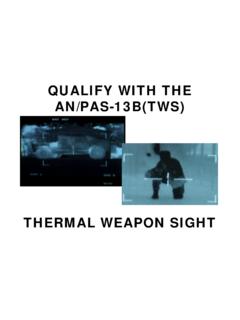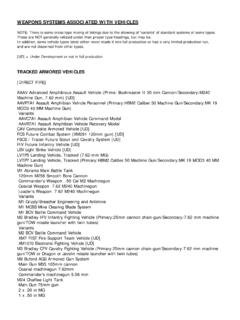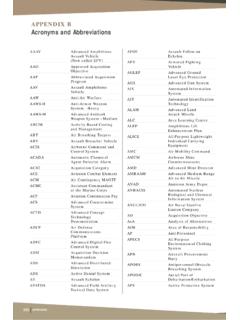Transcription of CHAPTER VI COMBAT IDENTIFICATION
1 CHAPTER VI. COMBAT IDENTIFICATION . A. DESCRIPTION. COMBAT IDENTIFICATION (CID) is the process of attaining an accurate characterization of entities in a combatant's area of responsibility to the extent that high-confidence, real-time appli- cation of tactical options and weapon resources can occur. The objective of CID is to maximize COMBAT /mission effectiveness while reducing total casualties (due to enemy action and fratricide). B. OPERATIONAL CAPABILITY ELEMENTS. forces must be able to positively identify all targets in the battlespace for all COMBAT mission areas air to air, air to surface, surface to surface, and surface to air.
2 Surface includes land, sea, and subsurface otherwise known as ground and maritime (Figure VI 1). The CID. need is essential in order for commanders to effectively field, at any time, fighting forces that can rapidly and positively identify enemies, friends, and neutrals in the battlespace; manage and control the battle area; optimally employ weapons and forces; and minimize total casualties. AWACS Commercial Aircraft E2-C. Surveillance COOPERATIVE. ENGAGEMENT CV-Launched Strike Merchant Ships CV Battle Group Joint Amphibious Group TBM. Battle Group Attacks Enemy Jamming Enemy Enemy Coastal Ground- Launched Enemy Ship Attack Missiles Air Attack Enemy Returning Helo CV Strike Aircraft Enemy Sub USAF COMBAT COMBAT ASCM Attack Aircraft USA Land Air Patrol COMBAT Force Figure VI 1.
3 Concept COMBAT IDENTIFICATION VI 1. JOINT WARFIGHTING SCIENCE AND TECHNOLOGY PLAN. In 1992, the Joint Requirements Oversight Council (JROC) validated the Joint Mission Need Statement (MNS), which describes the broad-based requirements for CID. The JROC re- validated the MNS in 1998. These include positive, timely, and reliable IDENTIFICATION of friends, foes, and neutrals; classification of foes by class, type, and nationality; and interoperability re- quired among the military and desired with allied nations. The challenges presented by the requirements necessitate a CID architecture that blends both nonmateriel and materiel solutions.
4 Nonmateriel solutions include doctrine; tactics, techniques, and procedures (TTP); and training. From a cost perspective, the nonmateriel solution to resolving a CID deficiency is com- pelling if it does not carry untenable constraints on the warfighter. However, nonmateriel solu- tions often need to be augmented by materiel solutions. These can be characterized as coopera- tive/noncooperative sensor systems and command, control, and communications (C 3 ) systems . in particular, digital datalinks and radios, each of which contributes a portion to the CID solution.
5 As such, CID is viewed as a capability, not a single system or program. A system-of-systems . approach is required. CID is the result of a process that appropriately and accurately characterizes the entities present in a combatant's area of responsibility. Effective CID can take place with varying de- grees of target IDENTIFICATION , depending on the conditions of the battlespace. At times, the extent of required IDENTIFICATION is only to rapidly distinguish among friendly, neutral, and adversary forces with high enough confidence to support weapon employment decisions.
6 At other times, IDENTIFICATION of target class ( , cruise missile, fighter, or bomber) or target recognition ( , target vs. decoy) is required to select the correct defensive or offensive tactical weapon response. In other cases, a more extensive characterization that identifies specific target parameters, such as platform type ( , MiG 29 vs. MiG 21) and intent ( , an active interceptor vs. a defector), is required to select optimal defensive weapons and to support weapon release decisions. In all cases, the goal for CID is to provide the necessary level of IDENTIFICATION to make correct weapon decisions.
7 This CID approach supports the attainment of military objectives while minimizing total casualties. The primary objective for CID is to correlate and assign a foe, friend, or neutral identifi- cation label to a target. The IDENTIFICATION label can be assigned at any time from initial detec- tion of the potential target to weapon employment. To be useful for a direct-fire engagement, the correct target label must be correlated to a sensor return that is in a weapon sight ( , radar, laser, or thermal sight). Indirect-fire weapons or supporting-fire weapons operate from a different perspective as they cannot see the target.
8 The IDENTIFICATION is made and sent to the weapon by the fire requester or a surveillance/reconnaissance platform; the weapon is correlated to the specified target position. As discussed earlier, there are two classes of materiel solutions: Sensors the target is characterized either noncooperatively ( , radar signal modulation, high-range resolution radar, or electronic support measures) or coopera- tively ( , MK XII IDENTIFICATION friend or foe (IFF) system or Battlefield COMBAT IDENTIFICATION System (BCIS)). VI 2. COMBAT IDENTIFICATION C3 (particularly digital datalinks and radios) the target declares (either periodically or when queried) its IDENTIFICATION and position in a reference frame that the shooter.
9 Can correlate with its own weapon and sensor system ( , Link 16). Additionally, C3 systems are a medium for passing ID information from other sensors or sources. Both approaches have their strengths and limitations. If an offboard sensor performs the interrogation and IDENTIFICATION , there is the added necessity to pass and correlate the required information in a timely fashion. This requirement to correlate an IDENTIFICATION label with a sen- sor return in the weapon sight is a key discriminator and a source of significant cost for the systems.
10 The vision is a fielded CID capability that ensures that all combatant platforms will have available the required IDENTIFICATION information in a timely fashion that is commensurate with the range and lethality of the platforms' weapons and sensors. The approach toward realizing this vision is through an integrated CID architecture that combines noncooperative and cooperative IDENTIFICATION sensors and systems with C3 (particularly digital datalinks and radios) capabilities. Such architecture supports the development of situational awareness the overall, general knowledge of the tactical battlefield environment, including the location of friendly, neutral, and enemy forces as well as the plan of action for battle.



